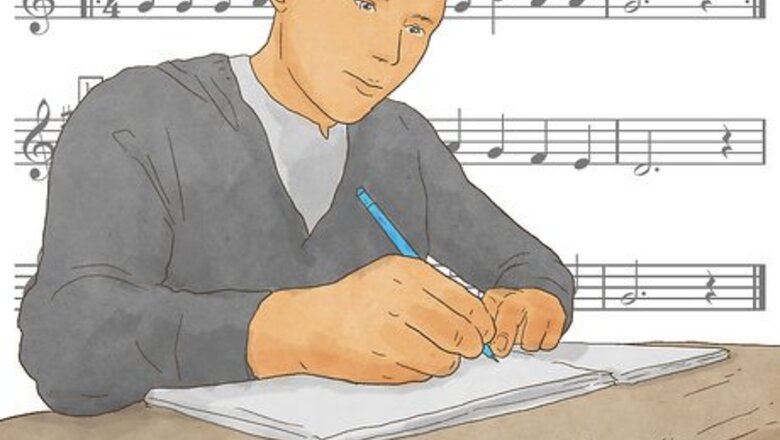
views
X
Research source
Building the Solo's Structure

Identify the key of the song you want to write a solo for. If you're writing a guitar solo you're likely in contact with the musician who wrote the song. This means you can easily find out what key the song was written in and the chords that were used. Or if you have sheet music, you can simply look at the key signature. Fool around on your guitar as you listen to the song 2 or 3 times. This may give you some early ideas for key tones or short licks that sound good.
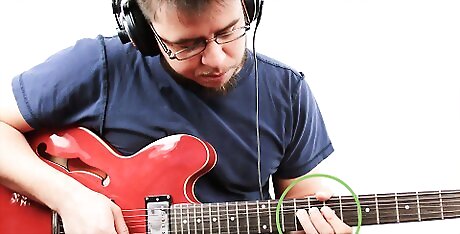
Determine which scale you want to use. Pentatonic scales include 5 notes of the regular scale, removing the 4th and 7th notes from each octave. The shape you make with your fretting hand can be moved up and down the neck to play the pentatonic scales of different keys. The Minor Pentatonic Scale is a versatile scale used in rock, blues, and pop songs, as well as some jazz music. For a song in E minor, you would play:E|---------------------0-3-|B|-----------------0-3-----|G|-------------0-2---------|D|---------0-2-------------|A|-----0-2-----------------|E|-0-3---------------------| The Major Pentatonic Scale is happier and brighter than the minor pentatonic scale and can be used in similarly bright songs. For a song in E major, you would play:e|-------------------------------------9--12--|B|------------------------------9--12---------|G|-----------------------9--11----------------|D|----------------9--11-----------------------|A|---------9--11------------------------------|E|--9--12-------------------------------------|
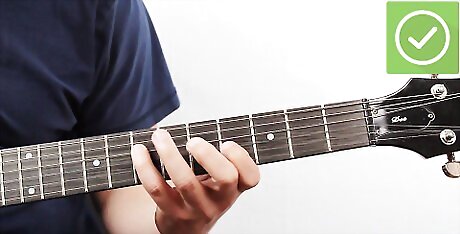
Improvise a little over the song. Playing over the song allows you to get comfortable with the chord changes and the general feel of the music. The pentatonic scale pattern sounds great over any chord change, so it frees you up to experiment a little and find something that sounds good. At this stage, you're just playing around. Don't put too much pressure on yourself to come up with the perfect solo on the spot. Just make a note of particular phrases you find that you really like.Tip: When playing over the song, play the root note of the chords to find the structure of the song on your fingerboard. This may also give you some ideas for riffs.
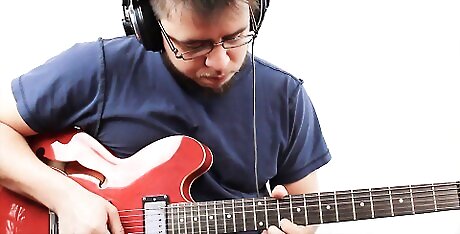
Choose simple whole notes to structure your solo. Try playing over the song again, and pick out 8 to 10 powerful notes that will serve as a sort of outline for your solo. Typically you'll place these notes on or immediately after chord changes. These whole notes will become the basic rhythm of your solo. From this framework you can branch out and improvise a little in between, knowing you have these notes to return to.
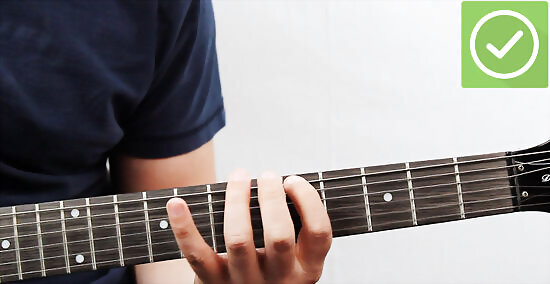
Find 4 or 5 motifs to connect listeners to the solo. A motif is a short 3- or 4-note phrase that you repeat several times throughout your solo. When you're writing your solo, come up with 4 or 5 you can possibly use, so you can choose the one that works the best. Keep your motif distinct from the main thread of your solo. For example, if you're using a phrase from the melody layered with a minor pentatonic scale, you might use a motif of 3 or 4 notes from the major pentatonic scale.
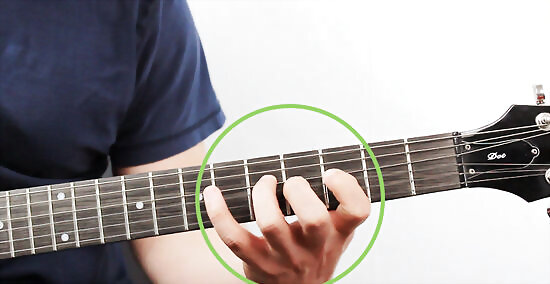
Incorporate pieces of the melody. Using a 4 or 5 note lick from the melody helps your solo fit in seamlessly with the rest of the song. Start with the same notes as the melody, then play the lick again, adjusting 1 or 2 notes. Continue doing this 2 or 3 times until you end with a lick that sounds nothing like the original melody. Then you can return to the melody. Gradually changing the notes balances the new with the old, taking your listeners on a journey with your solo and then bringing them back to where they started. Consider how the mood changes as you alter notes. For example, if you drop a couple of notes to minor tones, the phrase starts to sound ominous and you build tension before bringing it back around.
Structure your solo as a story with a beginning, middle, and end. Start slow, including short phrases or pieces of the melody. Gradually build tension and drama through the middle, working up to the ending climax of your solo. Typically you want to end triumphantly, with the best phrase of the solo or a particularly fast set of notes. Then the other musicians will come back in to play the rest of the song where they left off. Taylor Swift Taylor Swift, Singer & Businesswoman Practice diligently to improve your skills. "I have to practice to be good at guitar. I have to write 100 songs before I write the first good one."
Adding Flair to Your Solo
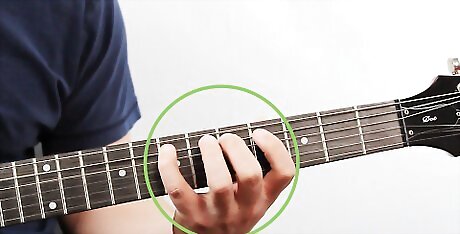
Use hammer-ons and pull-offs to play notes faster. Hammer-ons and pull-offs are two essential techniques to use if you're soloing on guitar. With a hammer-on, you basically tap the string with your finger on a higher fret to play another note without strumming. A pull-off is the reverse, when you remove a finger on a higher fret so that the string plays a lower note. When done correctly, the 2 notes slur together, creating a smoother sound. And since you don't have to strum each note separately, you can play much faster. Combine the techniques and go back and forth between 2 notes for several beats to create a sort of trill in your solo. This works well at the end of phrases.
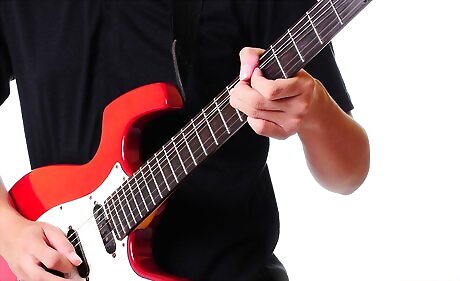
Mix in chords to bring power and drama to your solo. It's commonly understood that lead guitarists play single notes rather than chords – but there's no rule that says you can never play a chord just because you're the lead guitarist. Use chords to add body to root notes in your solo or emphasize a particular phrase. For example, if you used whole notes to build the basic outline of the structure of your solo, you could play some or all of those notes as chords, then fill in with single notes in between.
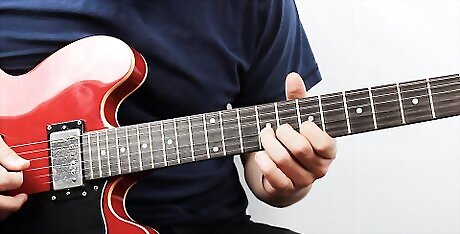
Bend strings at the end of phrases. To bend a string, fret it with 2 fingers and pull it across the fingerboard. As the string gets tighter, the pitch will go up. Pull from your wrist to bend the string, using your fingers as levers. This puts less pressure on your fingers and wrist by distributing the effort. Don't try to bend a string if it's not in tune. You could break the string. If you've never bent strings before, it's a technique that will take some practice to get right. Play the note you want to bend, then the note you want to bend the string to. That way you'll know when you've bent it far enough.

Use vibrato to add emotion to your solo. Vibrato is a technique similar to string bending, except that you gently move the string up and down for a slight variation in pitch. Lock your fretting finger against the neck of your guitar to get a good pivot point, then wobble that finger up and down after strumming the note. Vibrato is more difficult on the outside strings, since you don't want to pull the strings off the side of the neck. Experiment with your vibrato, doing it at different speeds and bending the string at different distances. A small, slow vibrato is typically more appropriate for ballads while bending the string further and faster works well with rock songs.
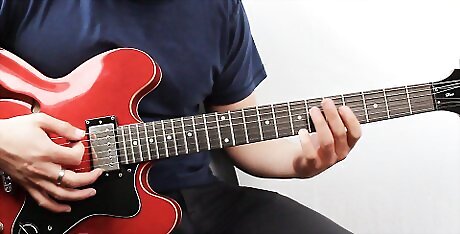
Throw in ideas borrowed from other guitarists. Listen to guitarists you admire and watch their solo technique. If you see something you like, practice it and try to emulate it. The same goes for motifs or riffs that capture your attention. Simply copying others won't make you a great guitarist. Once you've learned how to emulate someone else's idea, play around with it and try to make it your own. All guitarists have influences, but the greatest have a signature style that builds on their influences rather than mimicking them.Tip: Borrowing a classic riff will bring a spark of recognition from your listeners, and can also bring a little humor to your solo – particularly if the feel of the riff is at odds with the overall feel of the song.
Introducing a Solo
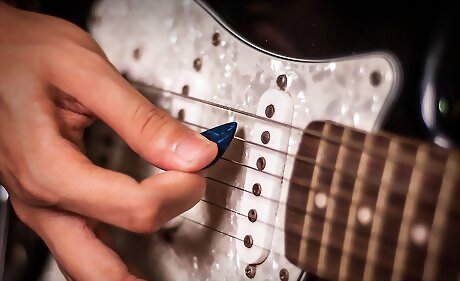
Kick off with a string bend and a pick scrape. Many rock guitar solos start out with the classic wail produced by a bent string. As the sound from the bend starts to fade, scrape the 2 lower strings with your pick to add some power to your solo. To make the pick scrape sound best, start below your pickups and run your pick up the 2 lowest strings. Leave some space between your fingers and the edge of your pick so your pick maintains flexibility.

Play a phrase from the melody in a different octave. Using this intro technique allows your solo to flow naturally from the song itself. Choose a phrase from the melody that you like and play it a couple of octaves higher, or a couple of octaves lower than it's played in the song. Playing a phrase from the melody a couple of octaves lower can give your solo a more ominous tone while raising it a couple of octaves produces a brighter tone. If you start with a phrase from the melody, you might also want to use a few notes from that same phrase as a motif running throughout your solo.Variation: Experiment with playing the phrase in a different mode than the song. For example, if the song is in G Major, you might start your solo with a phrase from the melody played in G Minor.
Run up and down the pentatonic scale. Start your solo on a root note of the accompanying chord being played, then follow with the next 4 notes in the pentatonic scale for that key. Play the same 5 notes from highest to lowest to bring your solo back to its base. Practice with different rhythms to make this simple opening more interesting for your listeners.
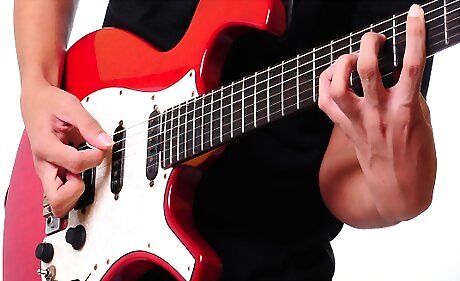
Combine opening techniques to add personal flavor. Once you've become familiar with different opening techniques, work on combining 2 or more to create a distinctive signature opening. There's no right or wrong way to do this – experiment until you find something you like. For example, you might start with a string bend, then pick scrape and move into a few bass notes of a phrase from the melody. Listen to acclaimed professional guitarists as much as you can to get ideas for what combinations work well together.



















Comments
0 comment